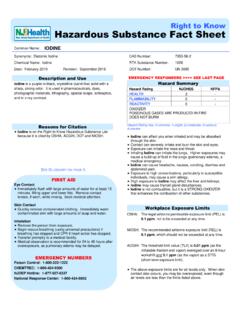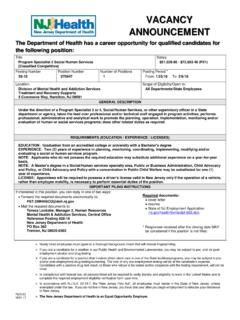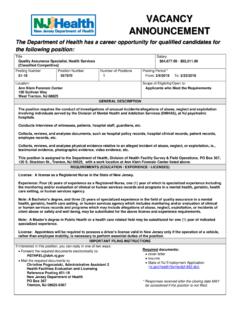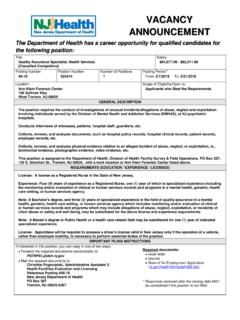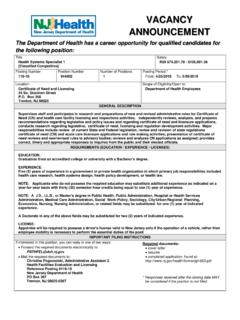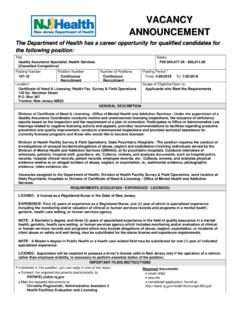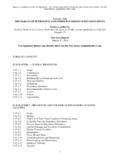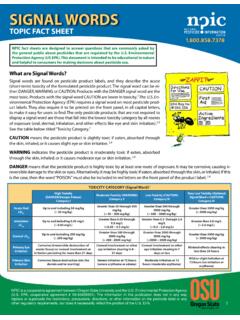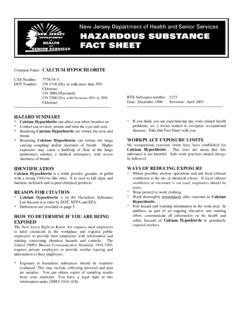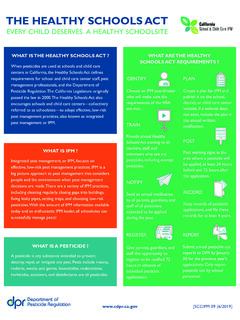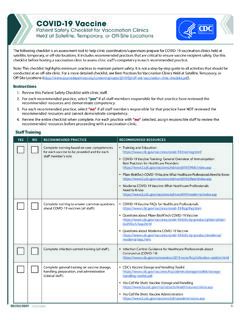Transcription of SODIUM DODECYLBENZENE SULFONATE - Government of …
1 Common Name: SODIUM DODECYLBENZENE SULFONATE CAS Number: 25155-30-0 DOT Number: UN 9146 ---------------------------------------- --------------------------------- HAZARD SUMMARY * SODIUM DODECYLBENZENE SULFONATE can affect you when breathed in. * Contact can irritate the skin and eyes with possible eye damage. * Breathing SODIUM DODECYLBENZENE SULFONATE can irritate the nose, throat and lungs causing coughing, wheezing and/or shortness of breath. IDENTIFICATION SODIUM DODECYLBENZENE SULFONATE is a white to light yellow sand-like solid.
2 It is used as a detergent, in cleaning products, and in pesticides . REASON FOR CITATION * SODIUM DODECYLBENZENE SULFONATE is on the Hazardous Substance List because it is cited by DOT and EPA. * Definitions are provided on page 5. HOW TO DETERMINE IF YOU ARE BEING EXPOSED The New Jersey Right to Know Act requires most employers to label chemicals in the workplace and requires public employers to provide their employees with information and training concerning chemical hazards and controls.
3 The federal OSHA Hazard Communication Standard, , requires private employers to provide similar training and information to their employees. * Exposure to hazardous substances should be routinely evaluated. This may include collecting personal and area air samples. You can obtain copies of sampling results from your employer. You have a legal right to this information under OSHA * If you think you are experiencing any work-related health problems, see a doctor trained to recognize occupational diseases.
4 Take this fact sheet with you. RTK Substance number: 1698 Date: May 1986 Revision: May 2002 ---------------------------------------- --------------------------------- WORKPLACE EXPOSURE LIMITS No occupational exposure limits have been established for SODIUM DODECYLBENZENE SULFONATE . This does not mean that this substance is not harmful. Safe work practices should always be followed. WAYS OF REDUCING EXPOSURE * Where possible, enclose operations and use local exhaust ventilation at the site of chemical release.
5 If local exhaust ventilation or enclosure is not used, respirators should be worn. * Wear protective work clothing. * Wash thoroughly immediately after exposure to SODIUM DODECYLBENZENE SULFONATE . * Post hazard and warning information in the work area. In addition, as part of an ongoing education and training effort, communicate all information on the health and safety hazards of SODIUM DODECYLBENZENE SULFONATE to potentially exposed workers. SODIUM DODECYLBENZENE SULFONATE page 2 of 6 This fact sheet is a summary source of information of all potential and most severe health hazards that may result from exposure.
6 Duration of exposure, concentration of the substance and other factors will affect your susceptibility to any of the potential effects described below. ---------------------------------------- ----------------------------------- HEALTH HAZARD INFORMATION Acute Health Effects The following acute (short-term) health effects may occur immediately or shortly after exposure to SODIUM DODECYLBENZENE SULFONATE : * Contact can irritate the skin and eyes with possible eye damage. * Breathing SODIUM DODECYLBENZENE SULFONATE can irritate the nose and throat causing coughing and wheezing.
7 Chronic Health Effects The following chronic (long-term) health effects can occur at some time after exposure to SODIUM DODECYLBENZENE SULFONATE and can last for months or years: Cancer Hazard * According to the information presently available to the New Jersey Department of Health and Senior Services, SODIUM DODECYLBENZENE SULFONATE has not been tested for its ability to cause cancer in animals. Reproductive Hazard * According to the information presently available to the New Jersey Department of Health and Senior Services, SODIUM DODECYLBENZENE SULFONATE has not been tested for its ability to affect reproduction.
8 Other Long-Term Effects * SODIUM DODECYLBENZENE SULFONATE can irritate the lungs. Repeated exposure may cause bronchitis to develop with cough, phlegm, and/or shortness of breath. MEDICAL Medical Testing If symptoms develop or overexposure is suspected, the following are recommended: * Lung function tests Any evaluation should include a careful history of past and present symptoms with an exam. Medical tests that look for damage already done are not a substitute for controlling exposure.
9 Request copies of your medical testing. You have a legal right to this information under OSHA Mixed Exposures * Because smoking can cause heart disease, as well as lung cancer, emphysema, and other respiratory problems, it may worsen respiratory conditions caused by chemical exposure. Even if you have smoked for a long time, stopping now will reduce your risk of developing health problems. WORKPLACE CONTROLS AND PRACTICES Unless a less toxic chemical can be substituted for a hazardous substance, ENGINEERING CONTROLS are the most effective way of reducing exposure.
10 The best protection is to enclose operations and/or provide local exhaust ventilation at the site of chemical release. Isolating operations can also reduce exposure. Using respirators or protective equipment is less effective than the controls mentioned above, but is sometimes necessary. In evaluating the controls present in your workplace, consider: (1) how hazardous the substance is, (2) how much of the substance is released into the workplace and (3) whether harmful skin or eye contact could occur.

